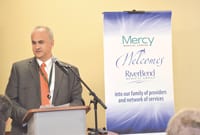Retaining Cash and Profits Separating Facts from Myths in Tax Planning and Financial Management
It is common practice of many physicians and dentists to strip out most, if not all, of the cash in their practice bank accounts by year end, thinking this is necessary to avoid paying income taxes.
Some doctors see it as their money and fear that, if they leave it in, someone else will get it. Tax accountants feel as though they are not doing their job properly if the practice owes income taxes on year-end profits, however small they may be. Practice managers, on the other hand, are tearing their hair out, worrying whether there will be enough cash to meet the next payroll and scheduled debt payments. Some managers are hesitant to disclose cash balances for fear the doctors will draw it out.
The objective of this article is to help doctors separate the facts from myths about tax planning, paying income taxes, and sound financial management.
A Common Mistake
Myth: Stripping out cash accounts and profits to pay bonuses is good financial management.
Most practices that run into financial difficulty are there because they have repeatedly stripped out all cash in their bank accounts, whether or not those cash balances resulted in taxable losses. If there was not enough cash to eliminate the taxable income, they borrowed to fund bonus payments, thinking that, as long as they have accounts receivable and other assets to borrow against, this is OK.
What they don’t realize, however, is that they are in a spiral of ever-increasing bank debt that will eventually make the practice insolvent.
The most stable and successful practices combine tax planning with good business sense. They recognize the need to retain cash and earnings in the practice for stability and growth, like any other business.
We recommend two rules of thumb. First, maintain a cash balance equal to two weeks of annual operating expenses. This is in addition to special accounts used during the year to accumulate cash for funding the practice’s annual retirement-plan contribution. Second, leave a taxable profit equivalent to 5{06cf2b9696b159f874511d23dbc893eb1ac83014175ed30550cfff22781411e5} of net income before doctor compensation.
Following this practice generally maintains the cash and capital required to sustain a healthy financial position without significantly altering doctor compensation.
Reasons for Retaining Cash
Most practices are undercapitalized from the beginning. In forming a new entity, doctors are reluctant to make an adequate level of capital contributions. Depending on the practice, we recommend $10,000 to $20,000 per doctor as an investment in return for their original issue of capital stock or equity interest.
This investment is generally returned to the doctor at retirement, as provided for in the practice stock redemption or partnership agreement. This is necessary to maintain some reasonable level of working capital and to fund certain startup costs. Doctors who contribute less than this will either have to retain a larger portion of future earnings or will be saddled with ever-increasing bank debt.
Practices make certain expenditures that are not tax-deductible, such as key person life insurance, disability insurance, certain meals and entertainment, redemption of stock, or equity of retiring doctors and memberships in IPAs, to name a few. Since these are non-deductible, they have to be paid in after-tax dollars.
Practice managers should not have to struggle every payroll and accounts-payable cycle to find enough cash because the practice is operating on a shoestring. This is crisis management. It is stressful and a waste of resources that should be spent in more productive ways.
Maintaining a reasonable cash balance gives the practice a cushion to withstand unexpected interruptions in cash flow resulting from payer problems, doctor absences, systems failures, etc., without having to rely 100{06cf2b9696b159f874511d23dbc893eb1ac83014175ed30550cfff22781411e5} on bank financing.
The Fallacy of Tax Avoidance
Myth: Bonusing out all profit at year end will avoid income taxes.
Tax planning is a very important element of running any business. However, there is a misconception among doctors that, by drawing out all profits, they are avoiding income taxes. This is simply not true. One may be able to defer the payment of income taxes to some future period, but eventually, bank loans will have to be repaid in after-tax dollars, which means income taxes will be paid in any event, whether at the individual level or entity level.
It doesn’t matter whether you operate as a professional corporation, S corporation, or LLC. The only difference is in the corporate versus individual rates. The tax cost of retaining an adequate level of operating cash and capital in a practice is even less significant when you factor in the alternative costs of bank financing incurred to ‘avoid’ taxes.
There is the possibility of some built-in gains or double taxation with professional corporations, but, with proper planning, this isn’t as big a financial issue as some would believe.
Bank Financing
Borrowing is a necessary element of running a practice. Generally, practices that incur no bank financing are either heavily capitalized by the owners or not making the necessary expenditures to grow and stay current with technology. However, like consumer credit, it should be used wisely with a plan to repay over an appropriate period.
Debt financing is a means to pay for growth and technology over a period commensurate with the use of the related resources. For example, financing a new information system costing $80,000 with a five-year installment loan enables the practice to even its cash flows over the period in which the equipment will be depreciated.
After five years, the practice will have paid and deducted the costs, and can then be in a position to finance a new system or needed enhancements. Similarly, financing office improvements with a repayment schedule extending the life of the lease results in a better matching of cash flows with costs recognized.
Every practice should also have a revolving line of credit to meet temporary cash shortfalls due to the unexpected. This debt is usually required to be repaid within a year or shorter period.
Balancing the Mix
Cash flow is the life blood of a doctor’s practice. Doctors who strip all cash and profits out of their practices every year will get caught in a spiral of ever-increasing deficits and debt service. In the long run, this will be the costliest way to finance their practice and will limit their ability to grow and keep pace with their industry peers. Eventually it will impact their own compensation and could impair their ability to recruit new doctors.
Tax planning is still a very important part of running a practice because it enables doctors to take advantage of available deductions and credits and the difference between individual versus corporate tax rates.
Practices that use the appropriate mix of retaining profits and debt financing will experience a more cost-effective use of resources and a more stable and predictable cash-flow pattern, and they will be better-positioned for growth and technological advancement.
James B. Calnan, CPA, is partner-in-charge of the Health Care Services Division of Meyers Brothers Kalicka, P.C. in Holyoke.


